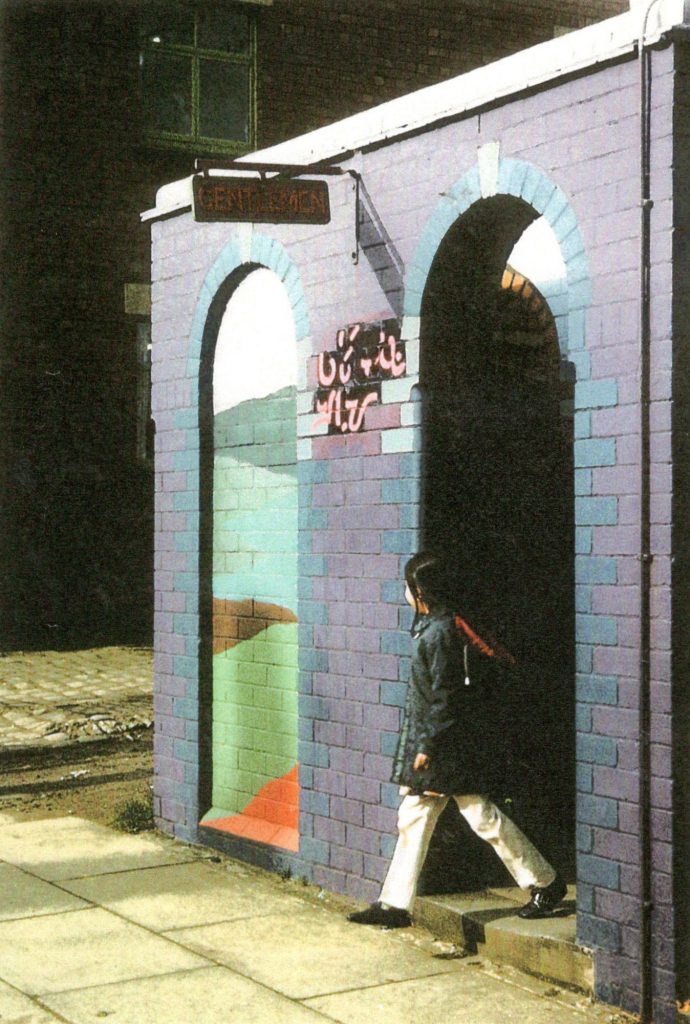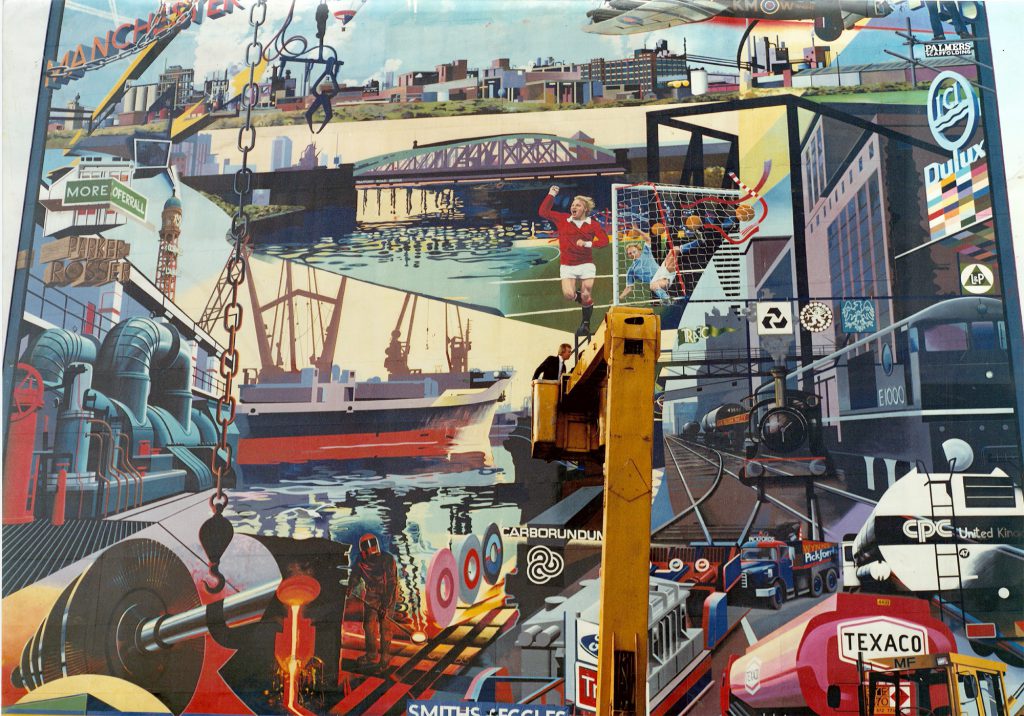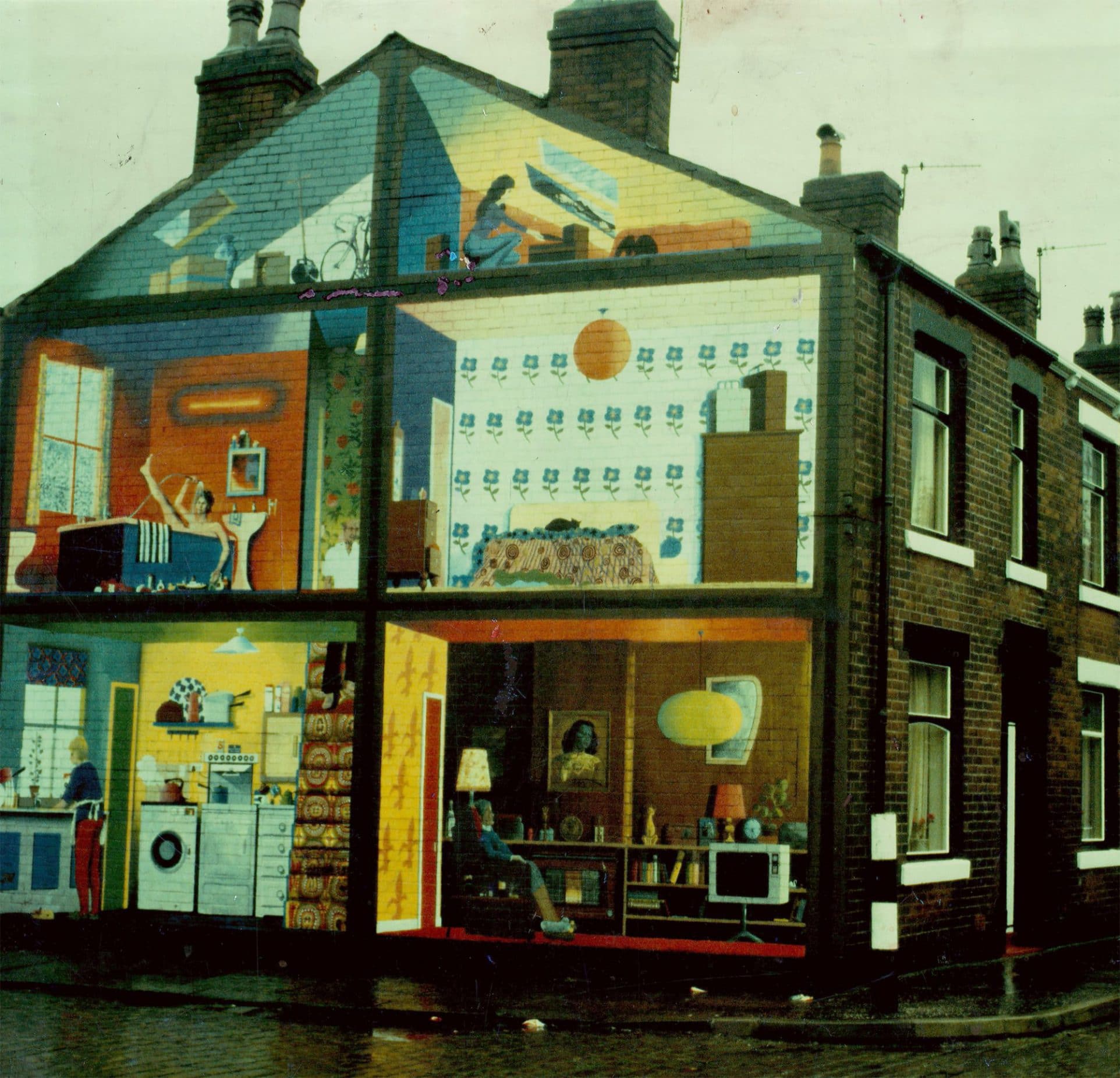Murals
Walter painted many murals in North-West of England, and others in London, Norfolk and Brazil.
Walter was born in December 1940.
It was a very happy childhood, “even though I spent the first seventeen years of my life living on council estates in Rochdale, it was a great education because you realise after that you will know how to take care of yourself, and any chance to travel you’ll take it!”
His father was a flight sergeant in the RAF and his mother was a printer and came from farming stock in rural Cambridgeshire. This was where Walter and his younger sister spent their summer holidays playing in the fields, doing farm jobs and exploring the City. He went to various schools in Rochdale till the age of ten and enjoyed doing art. After passing the eleven-plus he went to De La Salle Catholic Boys School in Salford.
“I was very keen on geography, because of this legacy I had of my father bringing home exotic foreign stamps from work, and because of this wanderlust I had – thinking how great it would be to travel.”
the lure of South America
He always wanted to do art and went for two years to Saturday morning art classes at Rochdale Art School in life drawing, and he began painting in oils and drawing his family at home. There were excellent art teachers who encouraged him to pass his ‘O’ and then ‘A’ levels and then to go on to Kings College at Durham University. Here he studied art for four years, and says he loved every minute of it. It was a traditional education, with lectures on anatomy, art and architecture history, drawing from casts and from the model, and tutors of note: Victor Passmore, Richard Hamilton and Laurence Gowing. Walter frequented the galleries: ‘ The Laing’ in Newcastle, and the major London galleries. In the ‘Wallace Collection’ he saw the Dutch masters he loved and at the ‘ Whitechapel ‘ discovered Pop Art and the work of Jackson Pollock.
In 1962 at the end of his course, determined to put all his energies into becoming an artist, he decided that he would teach no more than eight hours a week, rather than the two or three days a week that most graduates opted for.
“I was doing paintings of pop groups and pop stars, motorbikes and aeroplanes, the emergence of black power and Martin Luther King and all sort of stuff. I didn’t have an agenda, I was just painting what I considered exciting pictures – young mans’ adventure images – and exhibiting in galleries all round Manchester. And I was getting calls to send pictures to an Oxford or London gallery for a show. I knew that if I just kept working hard and was determined things would eventually come round to my way. I was also teaching at the Arts and Crafts Centre in Bury, and learning to work in three dimensions, making sculptures in resin or casting in aluminium. And every year I’d be designing and working with other artists making carnival floats for the Bury Carnival.”
to Italy on his Yamaha
“The first big mural I did was on the side of a building in the middle of Rochdale on a typical terrace house. And there was a Pakistani man living in it, so I asked would he mind having a flower on his house? ‘ No’ he said, ‘ carry on.’ I wanted a great big flowery image with lovely curves and rich colours to contrast with the awful urban architecture, the dreadfulness of the housing conditions. That was ‘ The Giant Pansies’. It’s one way of introducing nature into the urban environment and a protest too. It was a time when masonry paint, vinyl and matt emulsions were becoming very popular, ideal for painting outside brickwork and decaying plasterwork, but I never painted on stone, it was against my principles.”
After this there were others like the ‘Spitfire Mural’ in which the iconic fighter plane dives spectacularly across the scene; and then one of Alvin Stardust. Granada Television brought the pop star down to film him and Walter beside it.
 “People of Heywood were dead chuffed”, says Walter. “In those days I would go around with my friends like Eric Kean and we’d just knock on a door, and people would say go ahead. And just as I was getting quite well known as a bit of a madcap artist I got a call from BBC 2: ‘Walter can you paint us a mural, how long will it take and can we make a film of you?’ and I said, ‘Yes, I’ve got one in mind and it will take about three weeks”.
“People of Heywood were dead chuffed”, says Walter. “In those days I would go around with my friends like Eric Kean and we’d just knock on a door, and people would say go ahead. And just as I was getting quite well known as a bit of a madcap artist I got a call from BBC 2: ‘Walter can you paint us a mural, how long will it take and can we make a film of you?’ and I said, ‘Yes, I’ve got one in mind and it will take about three weeks”.
He commandeered four of his friends, who each chose parts and worked with him to paint the work, with all its delicious features.
“ The humour was just rubbing off us all while we were painting, and people were just laughing. Tony Smart, he painted the Tretchikoff, I painted Granny sitting in the front room drinking a half of Guinness waiting for the television to come on, Stewart Dawson painted all the ornaments, Arnold Solomon said, ‘ I’ll paint all the stencils for the wallpaper designs’. Peter Dent painted the ‘ Hygena QA’ for the fitted Kitchen, and I painted the dad coming down the stairs with his Black and Decker. Painting on the streets was very exciting, so much fun, and marvellous to talk to the local people coming home from work or from the shopping and children coming out of the school opposite, and sharing its humorous vision of life and times.”
His friend Ian Potts filmed him doing these early paintings. It was called ‘ Walter, The First Graffiti Artist’ and was shown at the Cannes Film Festival and won the gold medal for the best student film. Until 1978 when he received a grant for two years from the Gulbenkian Foundation, Walter was funding his murals from his own pocket.
‘The Inside – Outside House’
It was slum clearance, which gave him and his friends such an opportunity to bring life and colour to the city, even though they knew the buildings were going to be pulled down, knew that it had to happen, but they did it anyway. Walter is scathing about local authorities’ housing policy and their robotic new architecture.
His major work of the period occurred after he gave a talk to architecture and arts students at Manchester University in 1978.

“I was approached by a Trafford town planner; he said would I be interested in designing and painting a mural on the first big building in Trafford Park? I said, yes, and told him it would best be painted on eight by four, six mil. plywood sheets. I went down and measured it up: sixty-four feet wide and seventy-five feet high, eleven layers of scaffolding, pulleys and racks. So I painted it in my studio helped by Brigitte Curtis and one or two other friends; they would do the blocking in and I’d do all the finished work, often with a sable brush. We used household gloss and it took four years to paint, and when it was finished it was nailed up on the wall by joiners. And then when the scaffolding was taken down it was unveiled by Denis Law in 1982. And it was fantastic!” The mural, the largest ever made in Britain, was paid for by the businesses in Trafford Park supplemented by Trafford Council and lasted the full shelf life that Walter estimated. There was a huge response by local people; the opening by Denis Law, just transferred to United from Turin, headlined national news – which he shared – to his huge delight – “with the Raising of the Mary Rose!”
the Trafford Mural opening
In 1992 Trafford Council took down his original mural and commissioned a new design to take its place. Because of his previous experience this one took only a year to complete. Among the offers Walter received following the success of the Trafford mural was one from the British Council which asked could he do a lecture tour in Berlin, Osnabrück, Bremen and Hamburg and asked him also to paint a mural for the Council of the University of Sao Paulo – which he did with university students – and asked would he subsequently paint one for the ‘Cultura Inglesia’ in Brazil, and this he did the following year.
In 1985 there followed “something of a love affair with Brazil” with frequent visits to give lectures and paint murals about Brazilian history and culture and make links with Britain. On one occasion mosaic murals were commissioned for the stations of Recife, which he made in his studio in Rochdale and had flown out for him to install. “Working with Brazilian workmen was a great pleasure,” he said. His dream of world travel was being fulfilled.
Since 1985 Walter has continued painting pictures, lecturing, participating in arts festivals and making murals in Britain and abroad.
